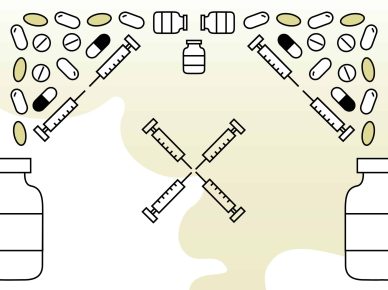by Rebecca Tiger in the Fall 2017 Contexts
As America’s opiate epidemic rages on, calls for “treatment not punishment” dominate the national media. The hypocrisy of this response is not lost on a range of commentators: the reported move away from criminalization, they argue, is yet another example of racist drug policy. White people get treatment and poor people of color get punishment. Again.
A cursory reading of national media seems to confirm this long-standing narrative of White, middle-class drug users as victims, not criminals. For example, the New York Times’ coverage of suburban drug users has invited sympathy and identification with the people in the stories, encouraging the reader to see themselves, their child, or someone they know in the stories of good people raised in loving families who became opiate addicts almost by accident. The accompanying pictures to these articles show white people hugging as they leave drug treatment and well-dressed parents looking at pictures of the son or daughter they’ve lost to heroin. Photos of attractive and smiling teenagers—someone’s children—remind us of the promise and potential extinguished by an overdose. And yet, the Times is also savvy enough to contextualize this new drug panic when they write, “In Heroin Crisis, White Families Seek Gentler War on Drugs” (Oct. 30, 2015). They subtly remind the reader that non-White addicts get punishment and harshness when they refer to the White opiate crisis as a “new era” characterized by “striking shifts… some local police departments have stopped punishing many heroin users.” It is only because the users are White that a redemptive narrative of families and police coming together to stop opiate use can gain traction in print and in legislative bodies.
And yet, this same media inadvertently invites a disruption to the dominant reading. In regional coverage of the opiate panic in Vermont, for example, the “crisis” of opiate use is framed as a “scourge” in quaint Bennington and in Rutland, a “blue-collar” town filled with addicts and drug dealers. The images accompanying these stories show a different tale of White drug use. Stephanie Predel, with dark circles under her eyes, is smoking a cigarette (itself a symbol of disrepute) in front of a ramshackle and dirty house. Alfred Hickey, looking tired and disheveled, is captioned to cast doubt: “[he] said he quit heroin.” Twenty-year-old Hailey Clark, here depicted as someone’s mother rather than daughter, is crying after losing custody of her son because of a heroin conviction. And two state troopers are pictured searching a suspect’s car for drugs. The story of opiates in Vermont is the opposite of innocence and community cohesion. As in suburban America, opiates are the culprit, but the response is markedly different. Poor White drug users get punishment.
While media coverage hints at this differential treatment among White users, an almost exclusive focus on racial inequality in drug policy has been repeated without question by both drug policy reformers and scholars. For good reason, many are ready to see yet another example of racism in current drug policy: drug scares have a deeply racist history. The “crack epidemic” of the 1980s is a stark example of the way the fear of drugs was used to justify increased criminalized repression of people of color. The egregious sentencing disparity between crack (coded as a Black drug) and powder cocaine (coded as a White drug), emerged through bi-partisan Congressional consensus. Sentencing disparities by race remain a hallmark of the War on Drugs. The first drug scares in the U.S., which were also about opiates, were reflections of thinly veiled anti-Chinese racism in the late 19th and early 20th centuries. Drug prohibition often relies on the image of a demonized racial other whose drug use threatens social stability.
But if we see only racial animus in drug scares, we overlook another engine of social control and harm: classism. The primary framing of the opiate epidemic as “White and middle-class” and the assumption that all White drug users have privilege serves to obscure the ways in which class figures prominently as a dividing line between which drug users are subjected to and exempted from punitive social control.
For the past several years, I have studied the opiate panic in Vermont. I’ve lived in the town often referred to as “the heroin capital of New England”, talking with drug users, addiction medicine doctors, prosecutors, judges, defense attorneys, police and probation officers, jail superintendents, harm reduction providers, and community members, many of them neighbors. The notion that this is a “gentler drug war” conflicts with the punitive response I see in practice, in which poor White drug users are caught at the intersection of the criminal justice, drug treatment, and child protection systems.
